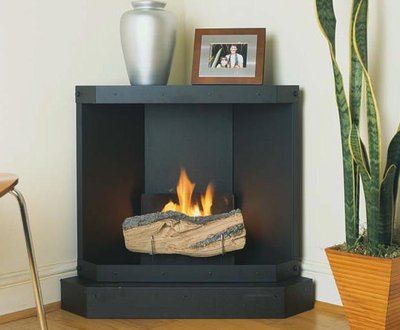Ventless Fireplace Inspection
 Ventless fireplaces are preferred because they burn at nearly 100% efficiency, release far less harmful gasses than most other portable heating alternatives, and their installation is restricted little by architectural constraints.
Ventless fireplaces are preferred because they burn at nearly 100% efficiency, release far less harmful gasses than most other portable heating alternatives, and their installation is restricted little by architectural constraints.To mitigate CO dangers, manufacturers instruct customers to keep a window open while ventless fireplaces are in operation –- advice that is easy to ignore, as an open window allows the entry of cold air, defeating the efforts of the fireplace to warm the living space. Many manufacturers also install an oxygen-detection sensor (ODS) in their ventless fireplaces that will automatically shut down the appliance if oxygen levels in the home become dangerously low. Critics point out that this sensor is typically located at the lower part of the unit near the floor, where it detects cool, fresh, oxygen-filled air and misses hot combustion gasses as they rise and pool toward the ceiling. And if the sensor fails, any CO-producing abnormality experienced by the fireplace will continue unnoticed and potentially harm building occupants.
The U.S. Department of Housing and Urban Development has banned the installation or use of ventless fireplaces in HUD housing. The HUD Handbook (7485.2) states the following:
(1) Individual Gas or Oil Heaters. Individual gas and
oil heaters shall be connected to an approved vent,
flue or chimney, and shall have adequate air supply
for complete fuel combustion. Heaters shall be
protected to prevent unsafe human contact or fires
and have clearances around them. Floors beneath
equipment shall be protected against fire and
deterioration. Screening shall not minimize required
ventilation to the space heater. When provided new
or replaced, individual controls or units shall not
be positioned near the floor, especially in elderly
projects or in units for the handicapped.
(2) Open Flame Heaters. Open flame radiant space
heaters shall not be used.Ventless fireplaces can be inspected for the following safety defects:
- a gas leak. During production, installation or servicing, a leak can be created;
- plugged burner ports. The contractor may accidentally plug the burner ports while spreading ceramic tile over the burners, or they may be painted over at the factory. The resulting unbalanced burn will create excessive carbon monoxide;
- a clogged burner. Dust, carpet lint and pet hair can gradually choke off the fireplace’s air supply, leading to incomplete combustion and high amounts of CO that are vented into the living space;
- high gas-input rate. Excessive CO ventilation or overheating of the unit will result from firing the gas higher than the input rate set by the manufacturer’s specifications. This can be caused by high gas-supply pressure, an incorrect orifice drill size done at the factory, or if the installer gives the customer's unit a larger flame for aesthetic reasons;
- the fireplace is oversized for the square footage of the area to be heated.
- a cracked burner. The gas burner may develop a crack over time and function erratically, producing high levels of CO;
- the fireplace contains items other than the artificial logs designed for the unit. Problems caused by the incineration of firewood or other flammable items will be immediate and extreme. A more likely and less obvious hazard is created by adding pebbles, lava rocks, and other non-combustible aesthetic touches to the fireplace, as their exposure to flames will cause an unsafe rise in levels of CO; and
- a missing or defective ODS. As these components may fail, it is advisable to install a CO detector near a ventless fireplace and, ideally, in other rooms, as well.

